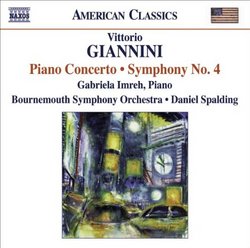| All Artists: Imreh Title: Giannini: Piano Concerto; Symphony No. 4 Members Wishing: 0 Total Copies: 0 Label: Naxos American Original Release Date: 1/1/2008 Re-Release Date: 1/27/2009 Genre: Classical Styles: Forms & Genres, Concertos, Symphonies Number of Discs: 1 SwapaCD Credits: 1 UPC: 636943935224 |
Search - Imreh :: Giannini: Piano Concerto; Symphony No. 4
CD DetailsSimilar CDs
|
CD ReviewsLush, tart and absolutely mesmerizing Gregory M. Walz | Salt Lake City, Utah United States | 02/07/2009 (5 out of 5 stars) "These two works by the American composer Vittorio Giannini (1903-1966) are tuneful, expansive, yet somehow powerfully concise, despite greatly varying lengths (41 minutes for the concerto, 23 minutes for the symphony). For such attractive scores, it is truly astounding that the pieces have apparently gone unperformed since their premieres (1937 for the concerto, 1960 for the symphony). The recording of these two scores reveals why Naxos for some time has been the premiere classical music label despite some occasionally poor performances and recordings--the depth and breadth of their coverage of the classical music idiom in a vast array of countries cannot be challenged. Giannini's piano concerto is long but never outstays its welcome, largely due to the sweeping lyricism tempered by a mastery of orchestration. Yes, there are hints of Rachmaninov, but never hints of what I sometimes find to be Rachmaninov's excess of notes to achieve a precisely desired splashy effect. The Symphony No. 4 is beautifully balanced by two denser outer movements that frame a magically gripping central movement labeled sostenuto e calmo. The outer movements merge great contrasts in dynamics with lush but tartly haunting lyricism. Despite being labeled neo-Romantic (or maybe rather because of it), this symphony is as powerful and masterful as any American symphony written in the twentieth century, and all in 23 minutes no less. The Bournemouth Symphony Orchestra under the baton of Daniel Spalding appear to astonished by the power, grip, and cohesion of the symphony, and it shows. There is a real depth and sheen to their sonority, some credit for which must go to Giannini's densely piquant scoring. The recording quality is excellent for the symphony, but perhaps a little too spacious for the concerto. Despite its beauty, it is unlikely that Giannini's piano concerto will ever soon be coming to a concert hall near you, notwithstanding pianist Gabriela Imreh's passionately and clearly voiced pianism. Today's orchestral programming appears to only really take consistent risks with new or overlooked scores that are somewhat brief--anything longer apparently needs to be by Beethoven, Rachmaninov, or Tchaikosky, at least where I live. What a shame. Yes, Giannini's Symphony No. 3 for wind band is a known quantity for that idiom (a Naxos recording is available), but Naxos should make it a priority to record Giannini's other symphonies (1-2, 5-7) and orchestral works. We are unlikely to ever hear them performed by major or even regional American orchestras. If there was justice in the world of American orchestral programming, Vittorio Giannini's Symphony No. 4 would be performed by major American orchestras. However, even the dazzling beauty of a 23 minute or so score will more than likely fall prey to the tag line of he must be a largely unknown composer for some good reason. So even though we live in America, instead of programming a richly deserving American composer (of Italian heritage), let's just program some more Beethoven, Rachmaninov, and Tchaikovsky. At least the masses will come. And so the life of great art at times remains as fickle as life itself." Very enjoyable music Howard M. Bushnell | NJ, USA | 05/09/2009 (4 out of 5 stars) "Thanks to Gabrielle Imreh for finding the manuscript and recording this wonderful concerto so well. (Yes, there are a couple of unobtrusive klunkers, but so what.) It's unusual to find unknown music that is so enjoyable and worthwhile. I've played it on "permanent repeat" for several days at a time, and I still like it!" More Unheard Giannini Makes It Onto Record J Scott Morrison | Middlebury VT, USA | 02/17/2009 (4 out of 5 stars) "Vittorio Giannini (1903-1966) was among those American composers of Italian heritage, including Paul Creston (né Giuseppe Guttoveggio) and Walter Piston (the family was originally named Pistone), who came to maturity before World War II and were important composers in the romantic or neo-romantic line. Giannini came from a musical family -- his mother was a violinist, his two sisters, Euphemia and Dusolina, were famed singers and teachers -- and he started early, being sent off to Milan from his hometown of Philadelphia at age nine to study at the Verdi Conservatory. He wrote prolifically, primarily operas early on -- my first taste of his music was seeing a production of his opera, 'Taming of the Shrew', in the early 1960s -- but also much instrumental music, including seven symphonies.
His Piano Concerto was written in 1934 and premièred in 1937 with the young Rosalyn Tureck as soloist. It received positive reviews but was never played again until this recording was made. In the CD's booklet, pianist Gabriela Imreh writes a touching note about learning the concerto for this recording. The work is a very old-fashioned piece, even for its time in the 1930s. It doesn't get much more modern than Rachmaninov or even Grieg, both of whose concerti it somewhat resembles. It is filled with soaring melodies, flashy octaves, filigree and chord-work for the soloist and although it is probably not a great work, it is immensely enjoyable. For me the finale is the high point; I particularly like its fugato section that leads into a heart-easing, broadly songful section toward the end of the work. The concerto is long -- forty-one minutes -- partly due to the young Giannini's addiction to long chains of sequences and his tendency to develop his materials to a fare-thee-well. Imreh does a superlative job of putting forth the work's many felicities, overcoming the virtuoso requirements with aplomb. But the most impressive work on this disc is the much shorter -- twenty-three minutes -- Symphony No. 4 (1959). It is a concise, tightly concentrated work whose musical language is considerably tarter than that of the concerto. It is highly chromatic but still tonal. The interval of the fourth figures importantly in its construction. The first movement is dramatic with islands of lyrical warmth. The second movement, sostenuto e calmo, is the expressive heart of the work particularly in the lushly romantic and heartfelt middle section. The allegro finale is at times martial or anguished but it opens up towards the end to a slow final section that recalls the melodic warmth of the middle movement before ending with a short scherzoso coda. Daniel Spalding and the Bournemouth Symphony do an outstanding job of presenting these works in a positive light. One could imagine a more lush presentation of the concerto, but the present recording will do nicely until some group like the Philadelphia Orchestra records it. Once again we owe thanks for the highly informative booklet notes of Walter Simmons, the leading scholar-advocate for the valuable roster of neo-romantic American composers, whose book 'Voices in the Wilderness: Six American Neo-Romantic Composers' is a must-have for anyone interested in this sub-genre of American music. Voices in the Wilderness: Six American Neo-Romantic Composers Another valuable recording of Giannini's music in this Naxos series: Giannini: Symphony No. 3; Praeludium and Allegro; Variations and Fugue Scott Morrison" |





